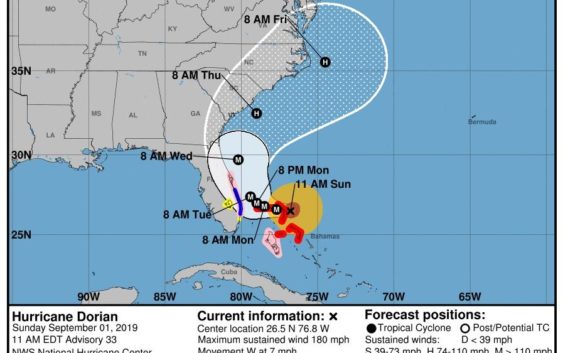- National memorial to honor NC firefighter who died on duty during Hurricane Helene
- Gov. Josh Stein extends State of Emergency for western NC wildfires
- Governor Stein extends state of emergency for NC wildfire threat
- Governor Stein extends emergency in 34 NC counties amid wildfire threat
- Texans can buy emergency preparation supplies tax-free April 26-28 ahead of severe weather season
11 a.m. update: Hurricane Dorian's winds increase to 180 mph

Track movement remains set to impact Southeastern North Carolina by Thursday
WILMINGTON — Southeastern North Carolina got a sense of deja vu Saturday as the region found itself inside the dreaded cone of uncertainty for Hurricane Dorian. That wasn’t altered with the latest update.
By 8 a.m. Sunday, the storm increased to a Category 5. As of 11 a.m., maximum sustained winds were reported at 180 mph, with Dorian sitting 205 miles east of the Florida coast.
The National Hurricane Center characterized Dorian as “the strongest hurricane in modern records” to target the northwest Bahamas. While the storm is likely to strike the island nation as a Category 5, forecasts still showed the storm weakening to at least a Category 2 by the time impacts are possible in the Carolinas.
The storm was still moving west at 8 mph, slowing for the next couple days before a gradual turn to the northwest. A hurricane warning was announced for the northwestern Bahamas, with tropical storm winds beginning Saturday night. Tropical storm winds could arrive in Southeastern North Carolina by Tuesday night.
However, with such drastic changes in the track of the storm over the past few days, the National Weather Service’s Wilmington office is cautioning local residents not to panic, but to be vigilant.
“The track will definitely continue to change, but to what degree we don’t know,” meteorologist Jordan Baker said Saturday afternoon. “It’s been changing so much, and we still have a lot to go. But we want people to have a plan now, so if we get closer and there looks like there could be impacts, you will be ready.”
Pender County Emergency Management said Saturday residents should use the weekend to prepare in case the storm does impact the area.
“This is the time to prepare,” said Tom Collins, Pender County Emergency Manager. “We could possibly experience high winds, rainfall, storm surge and flooding by Thursday.”
At area gas stations, it was hard to tell whether the long lines were for Labor Day traffic or the early signs of hurricane prep. But at grocery stores, the preparation for Dorian were clearly underway. Some people reported shelves cleared of water, while area Food Lions had already put out dozens of extra cases.
Gov. Roy Cooper officially declared a state of emergency for North Carolina on Saturday night. On Friday, he had allowed certain restrictions to be waived in order to help farmers and support relief efforts in advance of the storm. With Saturday’s early forecast, he expanded the order to ensure critically needed items like fuel, water and food can be distributed should the state be affected by the storm.
Stay up to date on news as it happens: Sign up for our free breaking news email alerts
“Now is the time to prepare and take Dorian seriously,” Cooper said in a release. “This storm could cause serious damage and bring dangerous conditions to our state. I urge everyone to follow the forecast and listen to their local first responders.”
At 3 p.m. Friday, Brunswick County issued a statement citing the NWS’ immediate concerns as ongoing tidal/coastal flooding and the increased threat for rip currents during Labor Day weekend. Coastal North Carolina residents who hit the beaches for the long weekend should be on the lookout for rough surf and strengthening rip currents beginning Saturday.
University of North Carolina Wilmington announced Friday it was monitoring the storm but did not anticipate any closures or delays early next week.
Due to the high uncertainty of the storm’s path, coastal residents should prepare their hurricane kits now and continue to monitor the storm throughout the weekend.
How to prepare before a storm hits:
Necessities
Water. 1 gallon per person, per day, prepare for a minimum of three days.
Battery-operated television or radio.
Extra batteries
Manual can opener
Local maps
Flashlights and waterproof matches
Cellphone with chargers, inverter or solar charger
Toilet paper
Baby supplies
Cash (ATMs may not work after the storm)
Rain gear (including a hat)
Bleach or water purification tablets
Soap and detergent
Moist towelettes, garbage bags and plastic ties for personal sanitation.
Charcoal/lighter fluid or portable camping stove
Disposable plates, glasses and utensils
Ice chest and ice
Valuable papers — insurance information, passports, Social Security cards, bank account and credit card numbers, wills, deeds, etc. — or copies, in a waterproof bag
Prescription and other necessary medicines
Blankets, tarp and masking tape
Dust mask to filter contaminated air, plastic sheeting and duct tape.
Three day’s worth of clothing, sleeping bags
First-aid kit, aspirin or pain reliever, anti-diarrhea medication, scissors, tweezers, bug spray
Feminine supplies and personal hygiene items
Fire extinguisher — ABC type
Extra pair of eyeglasses
Extra house, car keys
Tools: Shut-off wrench, pliers
Needles, thread
Whistle
Signal flare
Games,books for entertainment
Petcare: leashes, pet carriers, food
Sunscreen and sunglasses
Food
Baby food, baby formula, powdered milk
Canned meats (Spam, chicken, ham)
Canned fish (tuna, sardines)
Canned meals: spaghetti, soup, stew, chili
Canned fruits and vegetables
Cereal, crackers and cookies
Instant coffee, tea bags, sodas, juice
Granola bars, nuts, trail mix
Peanut butter and jelly
Sugar, salt, pepper
Sources: American Red Cross; FEMA; N.C. Emergency Management